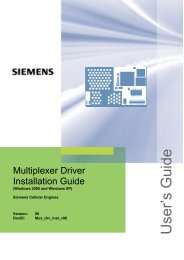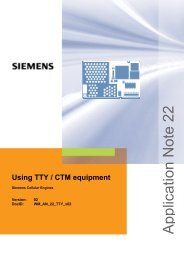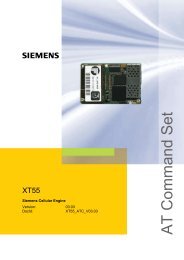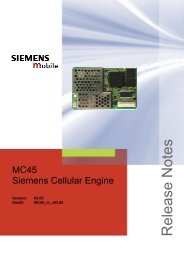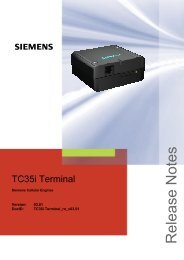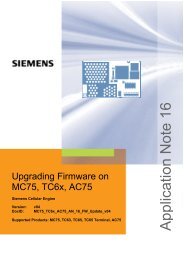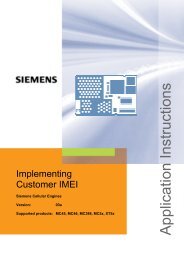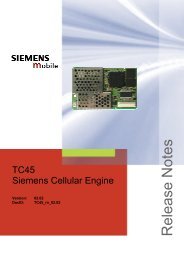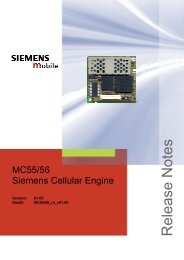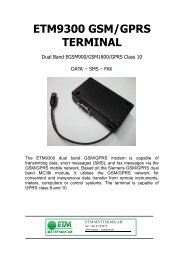Hardware Interface Description - Wireless Data Modules
Hardware Interface Description - Wireless Data Modules
Hardware Interface Description - Wireless Data Modules
Create successful ePaper yourself
Turn your PDF publications into a flip-book with our unique Google optimized e-Paper software.
MC55/56 <strong>Hardware</strong> <strong>Interface</strong> <strong>Description</strong><br />
Confidential / Released<br />
s<br />
Contents<br />
0 Document history..........................................................................................................7<br />
1 Introduction ...................................................................................................................9<br />
1.1 Related documents................................................................................................9<br />
1.2 Terms and abbreviations .....................................................................................10<br />
1.3 Type approval ......................................................................................................13<br />
1.4 Safety precautions ...............................................................................................15<br />
2 Product concept..........................................................................................................17<br />
2.1 MC55/56 key features at a glance .......................................................................18<br />
2.2 Circuit concept .....................................................................................................21<br />
3 Application <strong>Interface</strong>...................................................................................................22<br />
3.1 Operating modes .................................................................................................23<br />
3.2 Power supply .......................................................................................................25<br />
3.2.1 Power supply pins on the board-to-board connector .............................25<br />
3.2.2 Minimizing power losses........................................................................26<br />
3.2.3 Monitoring power supply........................................................................26<br />
3.3 Power up / down scenarios..................................................................................27<br />
3.3.1 Turn on MC55/56...................................................................................27<br />
3.3.1.1 Turn on MC55/56 using the ignition line /IGT (Power on) ..........28<br />
3.3.1.2 Timing of the ignition process.....................................................29<br />
3.3.1.3 Turn on MC55/56 using the POWER signal...............................30<br />
3.3.1.4 Turn on MC55/56 using the RTC (Alarm mode).........................30<br />
3.3.2 Turn off MC55/56...................................................................................32<br />
3.3.2.1 Turn off MC55/56 using AT command .......................................32<br />
3.3.2.2 Emergency shutdown using /EMERGOFF pin ...........................33<br />
3.3.3 Automatic shutdown...............................................................................34<br />
3.3.3.1 Temperature dependent shutdown ............................................34<br />
3.3.3.2 Temperature control during emergency call...............................35<br />
3.3.3.3 Undervoltage shutdown if battery NTC is present......................35<br />
3.3.3.4 Undervoltage shutdown if no battery NTC is present.................36<br />
3.3.3.5 Overvoltage shutdown................................................................36<br />
3.4 Automatic GPRS Multislot Class change.............................................................37<br />
3.5 Charging control ..................................................................................................38<br />
3.5.1 Battery pack characteristics...................................................................39<br />
3.5.2 Implemented charging technique...........................................................41<br />
3.5.3 Operating modes during charging..........................................................42<br />
3.5.4 Charger requirements............................................................................43<br />
3.6 Power saving .......................................................................................................44<br />
3.6.1 No power saving (AT+CFUN=1) ............................................................44<br />
3.6.2 NON-CYCLIC SLEEP mode (AT+CFUN=0)..........................................44<br />
3.6.3 CYCLIC SLEEP mode (AT+CFUN=5, 6, 7, 8) .......................................44<br />
3.6.4 CYCLIC SLEEP mode AT+CFUN=9 .....................................................45<br />
3.6.5 Timing of the /CTS signal in CYCLIC SLEEP modes ............................45<br />
3.6.6 Wake up MC55/56 from SLEEP mode ..................................................47<br />
3.7 Summary of state transitions (except SLEEP mode)...........................................49<br />
3.8 RTC backup.........................................................................................................50<br />
3.9 Serial interfaces ...................................................................................................51<br />
3.9.1 Features supported on first and second serial interface........................52<br />
3.10 Audio interfaces ...................................................................................................54<br />
MC55/56_hd_v02.06 Page 3 of 105 29.10.2004



